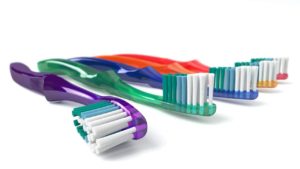But It’s Just A Toothbrush…..
Things You Didn’t Know About Your Toothbrush

Look for the ADA Seal
The ADA Seal of Acceptance is the gold standard for toothbrushes. That way you know that the bristles won’t fall out with normal use, the handle will stay strong and the toothbrush will help reduce your risk for cavities and gum disease.
The toothbrush is 5,000 years old–
In many different forms, that is. Ancient civilizations used a “chew stick,” a thin twig with a frayed end, to remove food from their teeth. Toothbrushes over time have evolved and were made from bone, wood or ivory handles and stiff bristles of hogs, boars or other animals. The modern nylon-bristled toothbrush we use today was invented in 1938.
There is not a “correct” order for brushing and flossing —
Brushing before flossing, flossing before brushing —it doesn’t matter to your teeth, as long as you do both.
Lifespan of your toothbrush–
Replace your toothbrush every 3-4 months, sooner if the bristles are frayed. A worn toothbrush will not do as good of a job cleaning your teeth.
When it comes to choosing a brush, go soft–
Whether you use a manual or an electric toothbrush, chose a soft bristle brush head. Firm or even medium- strength bristles may cause damage to your gum tissue and enamel.
Sharing is caring, but not for toothbrushes–
Sharing a toothbrush can mean you’re also sharing germs and bacteria. This could be a concern if you have a cold or flu to spread, or if you have a condition that leaves your immune system compromised.